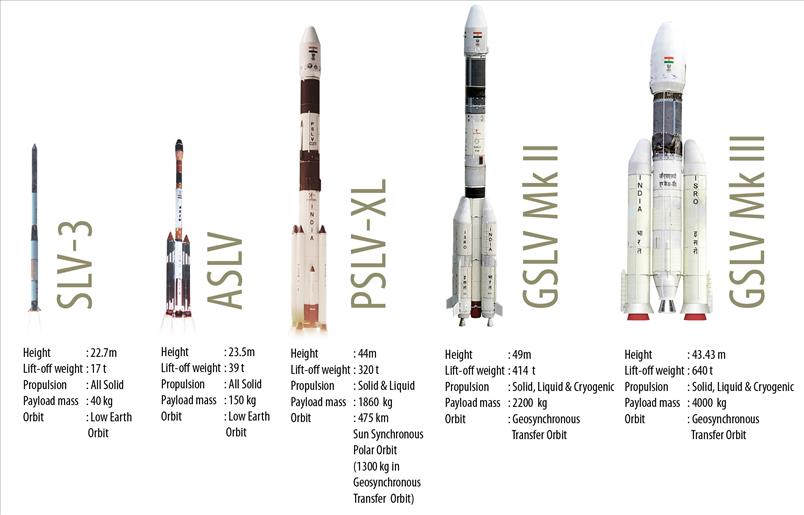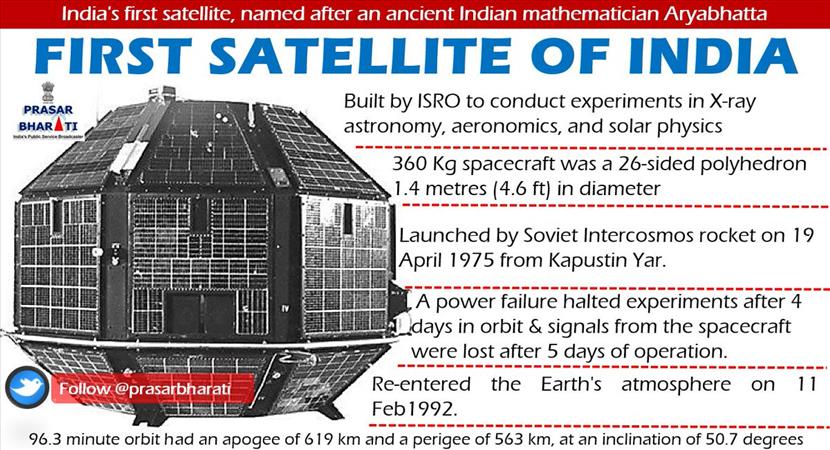Article /
Science & Technology /
Science & Technology
Indian Space Research Organisation's (ISRO) space odyssey, a timeline |
From the days of having a church as control room, the
bishop's house as office and a bicycle as ferry and naked eyes to track the
smoke plume at Thumba in Kerala and converting a toilet into a satellite data
receiving centre in Bengaluru, Indian space odyssey have come a long way to
ferrying foreign satellites, launching moon and Mars orbiters, and now planning
to land on the Moon. Here's a timeline of the epic journey.
India's Launch Vehicles
1960s-1990s: The period of trials and turbulations
1962: Indian National Committee for Space Research set up by
Department of Atomic Energy and work on establishing Thumba Equatorial Rocket
Launching Station (TERLS) started in Kerala.
1963: First sounding rocket launched from TERLS November 21,
1963.
1965: Space Science and Technology Centre established in
Thumba, Kerala.
1968: Experimental Satellite Communication Earth Station set up
at Ahmedabad, Gujarat.
1969: Indian Space Research Organisation (ISRO) formed under
the Department of Atomic Energy (August 15, 1969).
1971: Satish Dhawan Space Centre (formerly SHAR Centre) was
formed in Sriharikota, Andhra Pradesh.
1972: Department of Space (DOS) established and ISRO brought
under DOS. ISRO Satellite Centre established at Bangalore. Space Applications
Centre established at Ahmedabad.
1975: Satellite Instructional Television Experiment (1975-76)
using an US satellite.
1976: First Indian Satellite, Aryabhata, launched on April 19,
1975. Named after the famous Indian astronomer, it was completely designed and fabricated at Peenya near Bangalore in India and launched by a Soviet Kosmos-3M rocket from Kapustin Yar.
Image Courtesy :http://prasarbharati.gov.in//
1977: Satellite Telecommunciation Experiments Project (1977-79)
using Franco-German Symphonie Satellite.
1979: Bhaskara-1, an earth observation experimental satellite,
launched. First experimental launch of Satellite Launch Vehicle (SLV-3) carrying
Rohini satellite. Satellite was not placed in the orbit.
1980: Second experimental launch of SLV-3 with Rohini
satellite. Mission successful.
1981: First developmental launch of SLV-3. Rohini satellite
placed in orbit. Launch of APPLE, an experimental geo-stationary communication
satellite. Launch of Bhaskara-2 by an USSR rocket.
1982: Launch of Insat-1A communication satellite by an US
rocket.
1983: Second developmental flight of SLV-3 placed Rohini
satellite in orbit. Insat system commissioned with the launch to Insat-1B
satellite.
1984: First Indian cosmonaut Rakesh Sharma was in Russian space
station Salyut-7 for eight days. He flew in a Russian rocket Soyuz T-11.
1987: First development launch of Augmented SLV (ASLV) with
satellite SROSS-1. Mission failed.
1988: Launch of Indian Remote Sensing (IRS) satellite IRA-1A
through Russsian rocket. Second developmental flight of ASLV with SROSS
satellite. Mission failed.
1990s onwards: The era of PSLVs and foreign exchange earnings
The 1990s saw PSLV rocket hitting success repeatedly and becoming the workhorse
of ISRO. The rocket also earned foreign exchange by launching foreign
satellites.
1991: Launch of second operational remote sensing satellite
IRS-1B.
1992: First successful launch of ASLV placing SROSS-C
satellite. Launch of Insat-2A, the first satellite of the indigenously built
second generation Insat series followed by 3 and 4 series.
1993: First developmental flight of Polar Satellite Launch
Vehicle (PSLV) with IRS-1E. Mission failed.
1994: Fourth developmental flight of ASLV with SROSS-C2.
Mission successful. Successful launch of PSLV placing IRS-P2 in orbit.
1996: Third developmental flight of PSLV with IRS-P3.
1997: First operational launch of PSLV carrying IRS-1D.
1999: PSLV started carrying foreign payloads (Korean and German
satellites) along with ISRO's satellite Oceansat.
2000 onwards: Getting ready the heavy rocket and going for
interplanetary missions.
2001: Successful launch of heavy rocket Geosynchronous
Satellite Launch Vehicle (GSLV) with GSAT-1 satellite. Launch of PSLV with
India's Technology Experimental Satellite and satellites from Belgium and
Germany.
2002: Launch of Kalpana-1 satellite on board PSLV rocket.
2003: Launch of GSat-2 onboard GSLV and Resourcesat-1 by PSLV.
2004: Launch of Edusat by GSLV's first operational flight.
2005: Commissioning of second launch pad at Sriharikota. Launch
of Cartosat-1, Hamsat by PSLV.
2006: Second operational flight of GSLV with Insat-4C. First
time an Indian rocket carried a communication satellite. Mission failed.
2007: Launch of Cartosat-2 with Space Capsule Recovery
Experiment and two foreign satellites and successful recovery of the space
capsule. Launch of Italian satellite AGILE by PSLV and Insat-4CR by GSLV.
2008: Launch of Israeli satellite Tecsar by PSLV. Launch of 10
satellites by a single PSLV -- 2 Indian and 8 foreign. Launch of India's first
moon mission Chandrayaan-1 by PSLV. Sanction for Chandrayaan-2 given by the
government.
2009: Launch of Radar Imaging Satellite (Risat-2) and Anusat
from Anna University (first satellite from an Indian University) by PSLV. Launch
of seven satellites by PSLV, including India's Oceansat.
2010: Failure of two GSLV missions. Launch of Cartosat-2B,
STUDSAT and three small foreign satellites by PSLV.
2011: Launch of Resourcest-2 and two small satellites by PSLV.
Launch of GSAT-12 by PSLV. Launch of Megha Tropiques and three small satellites
by PSLV.
2012: Launch of Risat-1 and SPOT by PSLV
2013: Launch of Saral satellite, IRNSS-1A (navigation
satellite) and Mars Orbiter by PSLV.
2014: Launch of GSAT-14 by GSLV rocket, IRNSS-1B and IRNSS-IC,
SPOT 7 and GSLV-Mk III testing Crew Module Atmospheric Reentry Experiment
(CARE).
2015: Launch of IRNSS-1D, DMC3 satellites from UK, GSAT-6,
Astrosat, GSAT-15 by Ariane rocket, TeLEOS, Singapore.
2016: Launch of IRNSS-1E, IRNSS-1F, IRNSS-1G, Reusable Launch
Vehicle-Technology Demonstrator, Cartosat-2 series, Scramjet Engine Technology
Demonstrator, INSAT-3DR by GSLV, SCATSAT-1, Resourcesat-2A and GSAT-18 by Ariane
rocket.
2017: Launch of Cartosat-2 Series, GSAT-9 by GSLV, GSAT-19 by
GSLV-Mk III, Cartosat, GSAT-17 by Ariane and IRNSS-1H (failed as heat shield did
not open).
2018: Launch of Cartosat, GSAT-6A by GSLV, IRNSS-1L, Flight
Testing of Crew Escape System for human space mission, NovaSAR, UK, GSAT-29 by
GSLV-Mk III, HysIS, GSAT-11 by Ariane and GSAT-7A by GSLV. ISRO decides to
transfer Lithium ion battery technology.
2019: Launch of Microsat-R, GSAT-31 by Ariane, EMISAT and
RISAT-2B and second moon mission Chandrayaan-2.
Chandrayaan-2, was launched by GSLV Mk-III, India's most powerful launcher to date, which has been completely designed and fabricated from within the country. With the launch of Chandrayaan-2, India became the fourth country ever to soft land on the lunar surface after USA, Russia and China ; and the first space mission to conduct a soft landing on the Moon's south polar region. Chandrayaan-2 will explore a region of Moon where no mission has ever set foot.
TAGS:
ISRO,
ISRO history,
ISRO timeline,
Indian Space Research Organisation,
ISRO space journey ,



